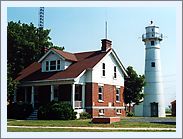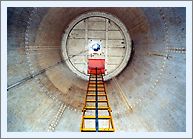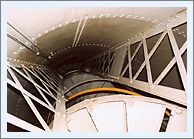|
Historical Information

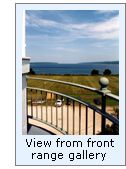 Grand Island stands guard at the entrance to Munising Bay, where
the south shore long served as a natural harbor of refuge to vessels
seeking shelter from the fury of Superior's late season storms. So
critical was the area considered by mariners that Superior's first
lighthouse the Grand Island North
Light was atop the 175-foot tall cliffs at the northern tip of Grand Island in 1856.
Serving to both warn coasting captains of the northern point of the
island and the safe harbor located to the south, vessels making for the
harbor were required to negotiate the narrow passages to the east and
west of the island without benefit of any navigational aids. Grand Island stands guard at the entrance to Munising Bay, where
the south shore long served as a natural harbor of refuge to vessels
seeking shelter from the fury of Superior's late season storms. So
critical was the area considered by mariners that Superior's first
lighthouse the Grand Island North
Light was atop the 175-foot tall cliffs at the northern tip of Grand Island in 1856.
Serving to both warn coasting captains of the northern point of the
island and the safe harbor located to the south, vessels making for the
harbor were required to negotiate the narrow passages to the east and
west of the island without benefit of any navigational aids.
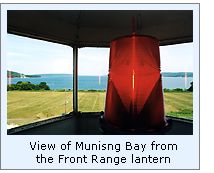 In
order to guide vessels into the safety of the harbor, the Lighthouse
Board constructed a pair of lights at the foot of each passage in 1868.
The Grand Island Harbor Range Lights on the mainland on the west edge of
Munising Bay, and the Grand Island East Channel
Light, a wood frame
schoolhouse-style structure on a peninsula at the southeast end of the
island. In
order to guide vessels into the safety of the harbor, the Lighthouse
Board constructed a pair of lights at the foot of each passage in 1868.
The Grand Island Harbor Range Lights on the mainland on the west edge of
Munising Bay, and the Grand Island East Channel
Light, a wood frame
schoolhouse-style structure on a peninsula at the southeast end of the
island.
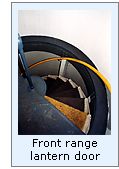 By 1905, the deteriorating condition of
the old East Channel Light and the increasing size of vessels entering
the harbor made it clear that the old station was no longer effectively
serving the needs of the maritime community, since its location at the
southernmost point of the island, rendered the light completely
invisible to vessels entering through the eastern passage until they
were almost abreast of the light itself. By 1905, the deteriorating condition of
the old East Channel Light and the increasing size of vessels entering
the harbor made it clear that the old station was no longer effectively
serving the needs of the maritime community, since its location at the
southernmost point of the island, rendered the light completely
invisible to vessels entering through the eastern passage until they
were almost abreast of the light itself.
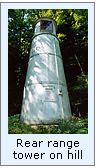 Determining that a set of range lights
located at the foot of the east channel within in the town of Munising
would serve as the best guide to captains making their way through the
east passage, the Board requested an appropriation of $13,200 for the
construction of such a station in its annual report for 1905. Congress
ignored the request, and convinced of the necessity for the expenditure
the Board reiterated the request in its report for the following year,
stating "If this appropriation is now made it will save the large
outlay necessary to renew the buildings of the present Harbor
Light." Determining that a set of range lights
located at the foot of the east channel within in the town of Munising
would serve as the best guide to captains making their way through the
east passage, the Board requested an appropriation of $13,200 for the
construction of such a station in its annual report for 1905. Congress
ignored the request, and convinced of the necessity for the expenditure
the Board reiterated the request in its report for the following year,
stating "If this appropriation is now made it will save the large
outlay necessary to renew the buildings of the present Harbor
Light."
 While Congress responded with an
appropriation on March 4, 1907, they felt that the amount requested was
excessive, and only appropriated the sum of $15,000 for the construction
of the new station. The plans for the station called out two steel
towers, the front range to be situated on low land close to the shore,
and the rear range on the hills that encircle Munising Bay. The contract
for the metal work for the towers was awarded to the Champion Iron
Company in Kenton, Ohio with the stipulation that the materials would
need to be delivered at the Munising site by August 3, 1908. While Congress responded with an
appropriation on March 4, 1907, they felt that the amount requested was
excessive, and only appropriated the sum of $15,000 for the construction
of the new station. The plans for the station called out two steel
towers, the front range to be situated on low land close to the shore,
and the rear range on the hills that encircle Munising Bay. The contract
for the metal work for the towers was awarded to the Champion Iron
Company in Kenton, Ohio with the stipulation that the materials would
need to be delivered at the Munising site by August 3, 1908.
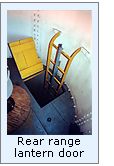 By
the end of June, the excavation for the towers and dwelling foundations
were complete, and work began on the 35 foot by 20 foot frame and brick
dwelling itself, which was the first such dwelling built to a plan that
subsequently be replicated down the coast at Grand Marais and at Point
Aux Barques on the west coast of Lake Huron. By
the end of June, the excavation for the towers and dwelling foundations
were complete, and work began on the 35 foot by 20 foot frame and brick
dwelling itself, which was the first such dwelling built to a plan that
subsequently be replicated down the coast at Grand Marais and at Point
Aux Barques on the west coast of Lake Huron.
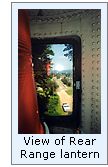 With the arrival of the ironwork from
Ohio, the construction crew's attention turned to the erection of the
two towers themselves. While the front range tower stood at 58 feet in
height, and rear range a diminutive 33 feet, their respective locations
on the shore provided the lights with focal planes of 79 feet and 107
feet respectively. The lanterns on both towers were outfitted with Adams
and Westlake 23-inch red reflector lights. Powered by incandescent
electric bulbs with power supplied by the Munising utility, these
reflectors output 35,000 candlepower, and were visible down range for a
distance of 19 miles. With the arrival of the ironwork from
Ohio, the construction crew's attention turned to the erection of the
two towers themselves. While the front range tower stood at 58 feet in
height, and rear range a diminutive 33 feet, their respective locations
on the shore provided the lights with focal planes of 79 feet and 107
feet respectively. The lanterns on both towers were outfitted with Adams
and Westlake 23-inch red reflector lights. Powered by incandescent
electric bulbs with power supplied by the Munising utility, these
reflectors output 35,000 candlepower, and were visible down range for a
distance of 19 miles.
Work continued on the station into the
fall, and the lights were exhibited for the first time on the night of
October 30th. Claiming that the deep water area to the south of Grand
Island had become "available during northerly storms as a refuge
for the largest class of vessel plying on the Great Lakes," the old
East Channel Light station was emptied of all valuable equipment and
supplies and abandoned to the wind and waves.

Keepers of
this Light

Click here
to see a complete listing of all Munising Range Light keepers compiled
by Phyllis L. Tag of Great Lakes Lighthouse Research.

Seeing this Light

Munising Front range light is located right in town, and completely
surrounded by homes and outbuildings, along with an incredible
conglomeration of power lines around the tower. The Rear Range is
located a block to the south on the bluffs that encircle the town.
In comparing the keeper's dwelling with
an old postcard in our collection, we were surprised at how little the
dwelling has changed over the years.

Finding this
Light

Take M28 into Munising from the East or West. The lighthouse is located
approximately two blocks from downtown on the West side of town.

Reference
Sources

Annual reports of the Lighthouse Board, 1860 - 1909
Great Lakes Light Lists, 1925 & 1939
Annual report of the Lake Carrier's Association, 1909
Great Lakes Coast Pilot, 1953, US Army Corps of Engineers.
Northern Lights, Charles K. Hyde, 1986
Personal observations at Munising, 09/11/98, 07/12/02 & 08/10/03.
Keeper listings for this light appear courtesy of Great
Lakes Lighthouse Research
|
